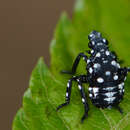en
names in breadcrumbs


Until the 1930s, the Spotted Lanternfly (Lycorma delicatula) was known mainly from Shanxi, Shandong, and Hebei provinces in northern China. Today, it is found across China (recorded from Anhui, Beijing, Guangdong, Henan, Hubei, Jiangsu, Shaanxi, Sichuan, Yunnan, and Zhejiang), as well as from Taiwan, Vietnam, and India, where temperatures are relatively higher than those in northern China (Xiao 1992 and Hua 2000, both cited in Kim et al. 2013). This species was reported sporadically from Japan (Okinawa, Honshu, and Kyushu) since the 1930s, but what its actual distribution was in Japan is uncertain. More recently, mass occurrences of L. delicatula have occurred in Japan in Hakusan, Ishikawa Prefecture, in 2008. This occurrence of sudden outbreaks of L. delicatula in Japan is very similar to what was seen in Korea, where this species was first identified in 2004 and over the next few years spread rapidly throughout the Korean Peninsula, where it is now widely distributed (Kim & Kim 2005 cited in Park et al. 2013; Han et al. 2008). This species appears to have become fully established in Korea as a consequence of the increase in winter temperatures in recent years, which has resulted in reduced mortality of overwintering eggs (Lee et al. 2011).
Spotted Lanternfly egg masses are often found on host plants and huge numbers of first instar nymphs can be observed every spring. Because of the importance of this species as an invasive pest, which can cause serious damage to grapevines (Shin et al. 2010; Lee et al. 2011) and other crops, it has been the subject of a number of investigations focused on its taxonomy, biology, ecology, ethology, and control within Korea. The Spotted Lanternfly damages its host plants primarily through the sucking of plant sap (Kim et al. 2011) and, secondarily, by spreading sooty mold disease (Lee et al. 2009).
In addition to grapes, this species is known to use at least 38 woody and four herbaceous species (Park et al. 2009). The main host is the Chinese Tree-of-heaven (Ailanthus altissima), on which the lanternflies feed, mate, and overwinter (as eggs). Tree-of-heaven, which is now widespread in Korea (as it is also in Australia, Europe, and North America), may facilitate the settlement and proliferation of Spotted Lanternflies (Lee et al. 2011).
(Kim et al. 2013 and references therein)
In 2014, the Pennsylvania Department of Agriculture confirmed the presence of this species in Berks County, Pennsylvania (U.S.A.), the first record from North America. This discovery sparked considerable concern about its potential to become a serious agricultural pest (Bureau of Plant Industry, Pennsylvania Department of Agriculture).
The complete mitiochondrial genome of Lycorma delicatula has been sequenced (Song et al. 2012).